HPS121 T2 2018 Deakin: Gender Differences in Attachment Styles Report
VerifiedAdded on 2023/06/10
|20
|3103
|189
Report
AI Summary
This lab report investigates gender differences in secure attachment styles based on attachment theory. It uses an independent measures t-test to analyze data from 1548 participants (474 male, 1064 female, and 10 other) with an average age of 29.90. The study examines secure, fearful, preoccupied, and dismissing attachment styles. The results indicated that while there was no significant difference in secure attachment scores, there was a significant difference in fearful attachment between males and females. The report discusses attachment theory, its roots in object relations theory, and the impact of early caregiver relationships. Desklib provides a platform to explore similar solved assignments and past papers.

Running head: PSYCHOLOGY 0
PSYCHOLOGY
Name of Student
Institution Affiliation
PSYCHOLOGY
Name of Student
Institution Affiliation
Paraphrase This Document
Need a fresh take? Get an instant paraphrase of this document with our AI Paraphraser
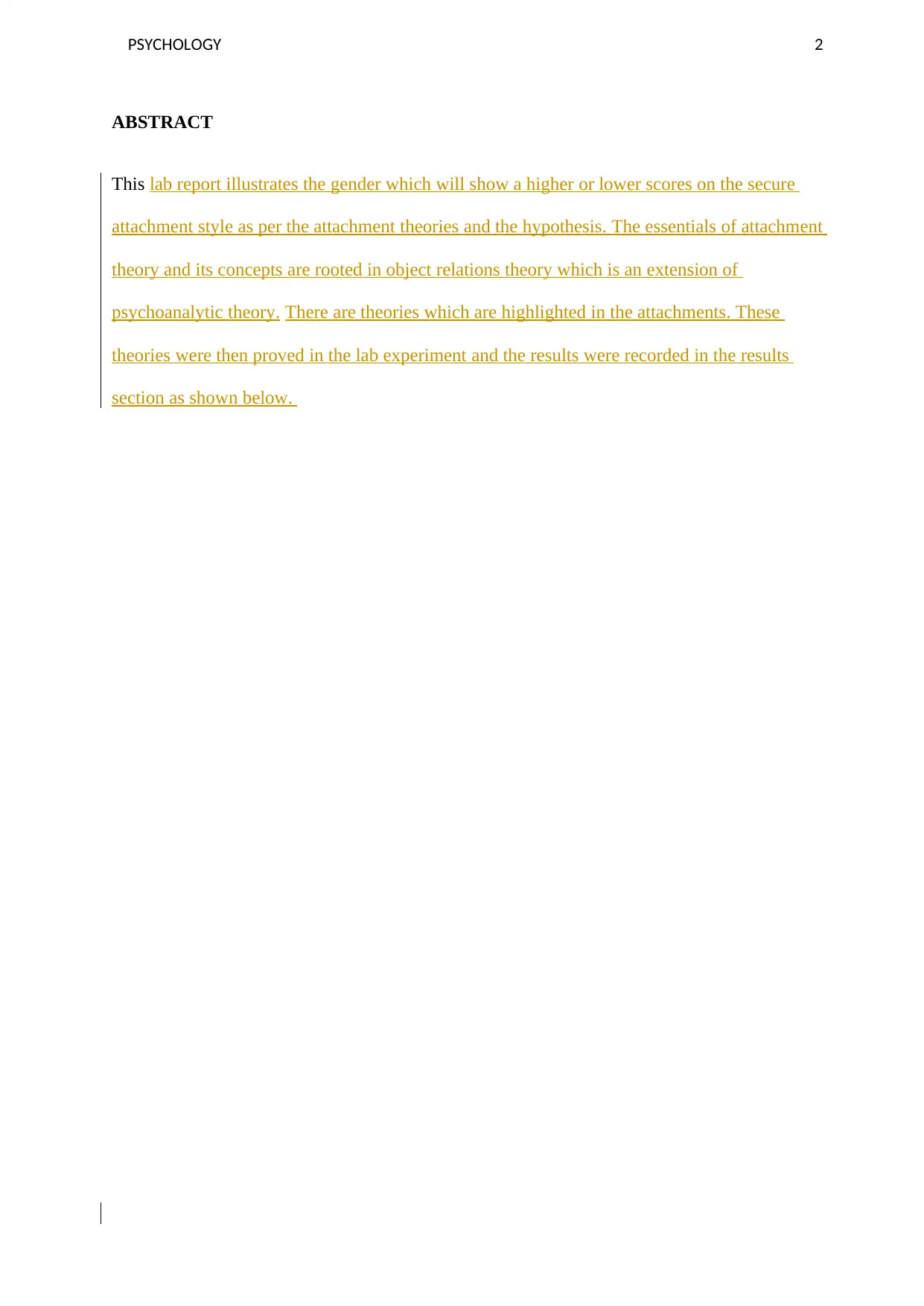
PSYCHOLOGY 2
ABSTRACT
This lab report illustrates the gender which will show a higher or lower scores on the secure
attachment style as per the attachment theories and the hypothesis. The essentials of attachment
theory and its concepts are rooted in object relations theory which is an extension of
psychoanalytic theory. There are theories which are highlighted in the attachments. These
theories were then proved in the lab experiment and the results were recorded in the results
section as shown below.
ABSTRACT
This lab report illustrates the gender which will show a higher or lower scores on the secure
attachment style as per the attachment theories and the hypothesis. The essentials of attachment
theory and its concepts are rooted in object relations theory which is an extension of
psychoanalytic theory. There are theories which are highlighted in the attachments. These
theories were then proved in the lab experiment and the results were recorded in the results
section as shown below.

PSYCHOLOGY 3
INTRODUCTION
Attachment theory is essentially concerned with the affection bond that evolves from
early interaction as in the attachment especially the mother as articulated by the Bowndly in
1982. Attachment style is established and maintained with the primary caregiver when the infant
is born and this early interaction influences the individual to a great extent in later life (Aron,
2013). The fundamentals of attachment theory and its concepts are rooted in object relations
theory which is an extension of psychoanalytic theory (Eccles, 2014). How children were
affected by the early attachment style when they become adults and develop their own
personalities. Ainsworth also went ahead together with her colleagues and identified attachment
styles existing in a mother-child relationship and they focused on the function of attachment
figure which primarily to offer comfort and security (Eckes, 2012). The grouping of the children
was done in three groups which include ambivalent or anxious, avoidant and secure.
Bowlby, 1969 simply viewed attachment as a deep emotional bond that connects one
person to another and, one person may have an attachment to an individual which is not shared.
Responding sensitively to the needs of children is one of the attachment behavior in adults while
seeking proximity to the attachment figure when threatened or upset is experienced in a child
(Eisenberg, 2015). It was proposed by Karairmak that attachment can be understood within an
evolutionary context such that safety and security are provided by the caregiver for the infant
thus enhancing their chance of survival. Freud and Bowlby went ahead and agreed on the
significant role of the family and strong impact on personality formation, socialization as well as
psychological and social development of the child (Goldberg, 2010). The child attachment to
parents affects one’s future and relationships with the others thus making attachment essential for
child’s growth (Lamb, 2013). An infant perceives himself or herself if in case a positive model is
developed by an infant and in case the caregiver is not responsible then an infant found himself
INTRODUCTION
Attachment theory is essentially concerned with the affection bond that evolves from
early interaction as in the attachment especially the mother as articulated by the Bowndly in
1982. Attachment style is established and maintained with the primary caregiver when the infant
is born and this early interaction influences the individual to a great extent in later life (Aron,
2013). The fundamentals of attachment theory and its concepts are rooted in object relations
theory which is an extension of psychoanalytic theory (Eccles, 2014). How children were
affected by the early attachment style when they become adults and develop their own
personalities. Ainsworth also went ahead together with her colleagues and identified attachment
styles existing in a mother-child relationship and they focused on the function of attachment
figure which primarily to offer comfort and security (Eckes, 2012). The grouping of the children
was done in three groups which include ambivalent or anxious, avoidant and secure.
Bowlby, 1969 simply viewed attachment as a deep emotional bond that connects one
person to another and, one person may have an attachment to an individual which is not shared.
Responding sensitively to the needs of children is one of the attachment behavior in adults while
seeking proximity to the attachment figure when threatened or upset is experienced in a child
(Eisenberg, 2015). It was proposed by Karairmak that attachment can be understood within an
evolutionary context such that safety and security are provided by the caregiver for the infant
thus enhancing their chance of survival. Freud and Bowlby went ahead and agreed on the
significant role of the family and strong impact on personality formation, socialization as well as
psychological and social development of the child (Goldberg, 2010). The child attachment to
parents affects one’s future and relationships with the others thus making attachment essential for
child’s growth (Lamb, 2013). An infant perceives himself or herself if in case a positive model is
developed by an infant and in case the caregiver is not responsible then an infant found himself
⊘ This is a preview!⊘
Do you want full access?
Subscribe today to unlock all pages.

Trusted by 1+ million students worldwide
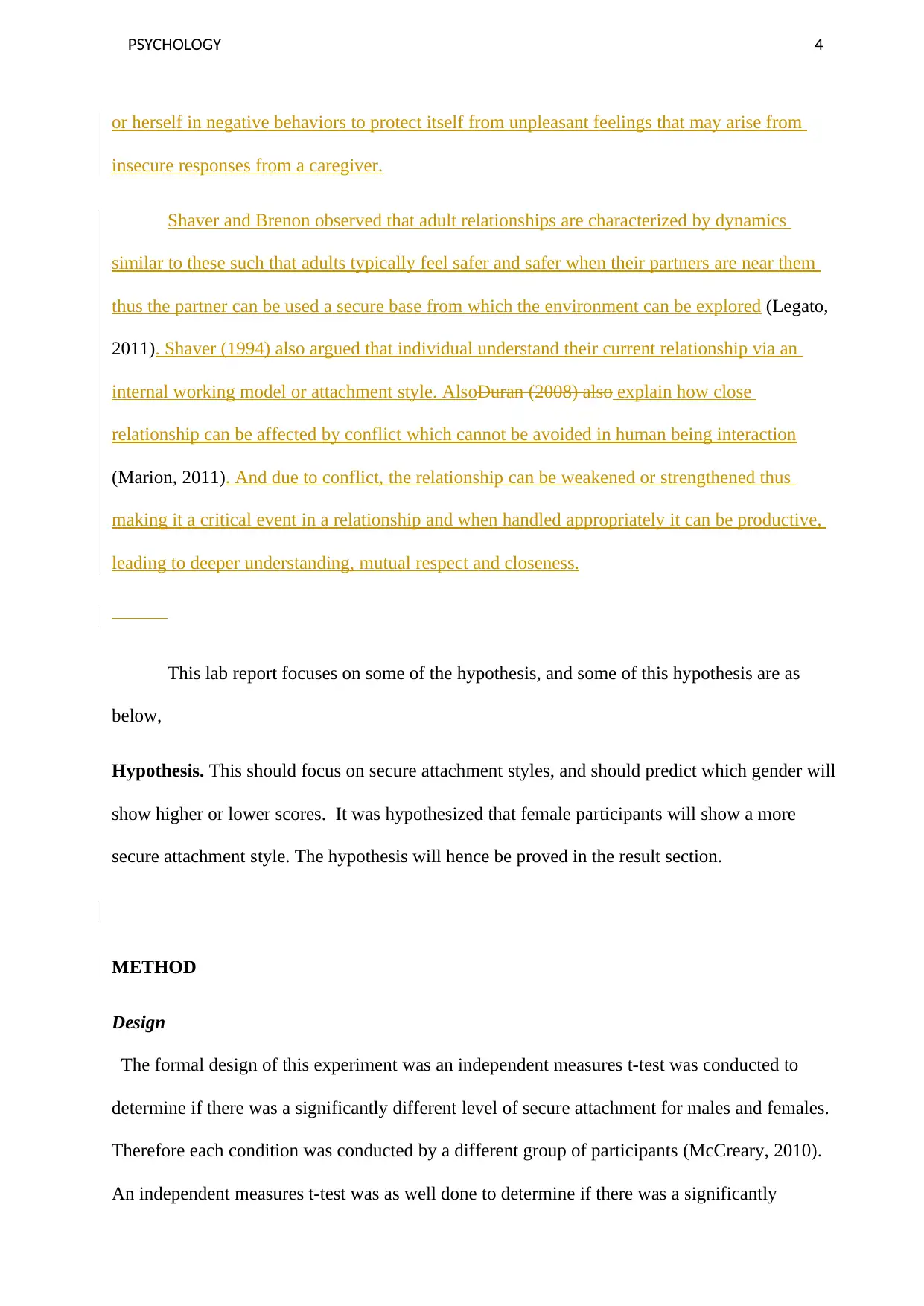
PSYCHOLOGY 4
or herself in negative behaviors to protect itself from unpleasant feelings that may arise from
insecure responses from a caregiver.
Shaver and Brenon observed that adult relationships are characterized by dynamics
similar to these such that adults typically feel safer and safer when their partners are near them
thus the partner can be used a secure base from which the environment can be explored (Legato,
2011). Shaver (1994) also argued that individual understand their current relationship via an
internal working model or attachment style. AlsoDuran (2008) also explain how close
relationship can be affected by conflict which cannot be avoided in human being interaction
(Marion, 2011). And due to conflict, the relationship can be weakened or strengthened thus
making it a critical event in a relationship and when handled appropriately it can be productive,
leading to deeper understanding, mutual respect and closeness.
This lab report focuses on some of the hypothesis, and some of this hypothesis are as
below,
Hypothesis. This should focus on secure attachment styles, and should predict which gender will
show higher or lower scores. It was hypothesized that female participants will show a more
secure attachment style. The hypothesis will hence be proved in the result section.
METHOD
Design
The formal design of this experiment was an independent measures t-test was conducted to
determine if there was a significantly different level of secure attachment for males and females.
Therefore each condition was conducted by a different group of participants (McCreary, 2010).
An independent measures t-test was as well done to determine if there was a significantly
or herself in negative behaviors to protect itself from unpleasant feelings that may arise from
insecure responses from a caregiver.
Shaver and Brenon observed that adult relationships are characterized by dynamics
similar to these such that adults typically feel safer and safer when their partners are near them
thus the partner can be used a secure base from which the environment can be explored (Legato,
2011). Shaver (1994) also argued that individual understand their current relationship via an
internal working model or attachment style. AlsoDuran (2008) also explain how close
relationship can be affected by conflict which cannot be avoided in human being interaction
(Marion, 2011). And due to conflict, the relationship can be weakened or strengthened thus
making it a critical event in a relationship and when handled appropriately it can be productive,
leading to deeper understanding, mutual respect and closeness.
This lab report focuses on some of the hypothesis, and some of this hypothesis are as
below,
Hypothesis. This should focus on secure attachment styles, and should predict which gender will
show higher or lower scores. It was hypothesized that female participants will show a more
secure attachment style. The hypothesis will hence be proved in the result section.
METHOD
Design
The formal design of this experiment was an independent measures t-test was conducted to
determine if there was a significantly different level of secure attachment for males and females.
Therefore each condition was conducted by a different group of participants (McCreary, 2010).
An independent measures t-test was as well done to determine if there was a significantly
Paraphrase This Document
Need a fresh take? Get an instant paraphrase of this document with our AI Paraphraser

PSYCHOLOGY 5
different level of fearful attachment for males and females and the results are given in the result
section (Paludi, 2014). An independent measures t-test was conducted to determine if there was
a significantly different level of preoccupied attachment for males and females and the results are
given in the result section below.
Participants
This part is very crucial as it gives the details of who took part in the experiment- it
provides the info of their age, gender, among other special feature which is directly related and
relevant to the experiment. For the type of the experiment, the participants were volunteers that
is they were not paid to give the information about the experiment, the participants were friends
and relatives to the students (Shaffer, 2013). And in the experiment there were about 1548
participants who completed the entire survey, they were friends and family of first-year
psychology students. And for the gender there were, 474 were male, 1064 female, and 10 other.
And on the age, it was taken to be an average age was 29.90 (having a standard deviation
of 14.09). The maximum was 84 years minimum age was 18 years (Shi, 2003). Of all the
participants, there were 745 participants who were students and 788 participants who were non-
students and 15 participants did not respond to the questions answered.
Apparatus
In psychology lab report, apparatus means things like the stopwatches, computers and
questionnaires which were employed to help obtain the results during the experiment (Paludi,
2014). And for this particular psychology lab report, it is the questionnaire which was
exclusively employed to help obtain the results (Underwood, 2013). Some of these question
asked includes the following; Do men and women differ in the types of attachment styles they
exhibit in adult life? A complete questionnaire is shown below;
different level of fearful attachment for males and females and the results are given in the result
section (Paludi, 2014). An independent measures t-test was conducted to determine if there was
a significantly different level of preoccupied attachment for males and females and the results are
given in the result section below.
Participants
This part is very crucial as it gives the details of who took part in the experiment- it
provides the info of their age, gender, among other special feature which is directly related and
relevant to the experiment. For the type of the experiment, the participants were volunteers that
is they were not paid to give the information about the experiment, the participants were friends
and relatives to the students (Shaffer, 2013). And in the experiment there were about 1548
participants who completed the entire survey, they were friends and family of first-year
psychology students. And for the gender there were, 474 were male, 1064 female, and 10 other.
And on the age, it was taken to be an average age was 29.90 (having a standard deviation
of 14.09). The maximum was 84 years minimum age was 18 years (Shi, 2003). Of all the
participants, there were 745 participants who were students and 788 participants who were non-
students and 15 participants did not respond to the questions answered.
Apparatus
In psychology lab report, apparatus means things like the stopwatches, computers and
questionnaires which were employed to help obtain the results during the experiment (Paludi,
2014). And for this particular psychology lab report, it is the questionnaire which was
exclusively employed to help obtain the results (Underwood, 2013). Some of these question
asked includes the following; Do men and women differ in the types of attachment styles they
exhibit in adult life? A complete questionnaire is shown below;
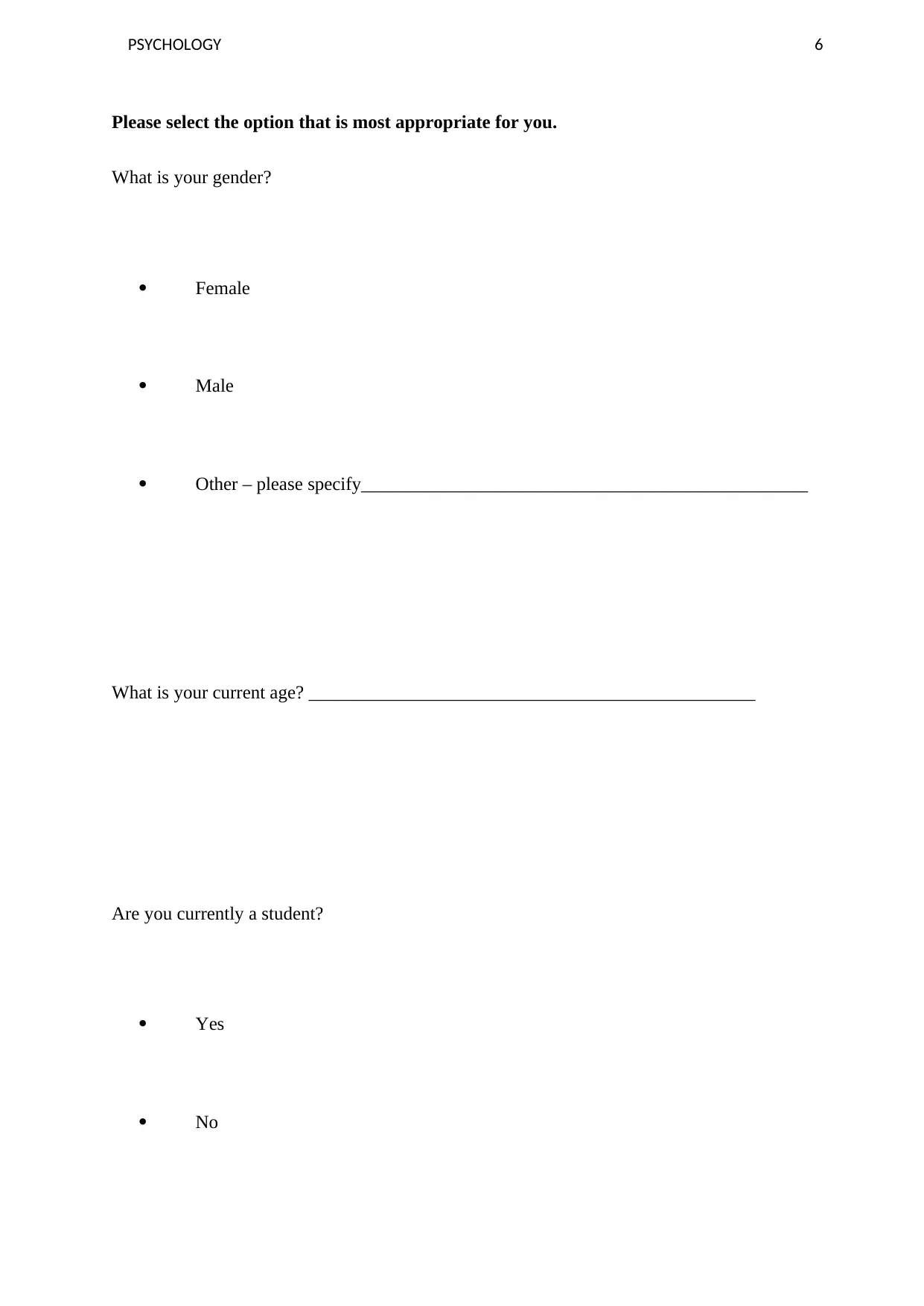
PSYCHOLOGY 6
Please select the option that is most appropriate for you.
What is your gender?
Female
Male
Other – please specify________________________________________________
What is your current age? ________________________________________________
Are you currently a student?
Yes
No
Please select the option that is most appropriate for you.
What is your gender?
Female
Male
Other – please specify________________________________________________
What is your current age? ________________________________________________
Are you currently a student?
Yes
No
⊘ This is a preview!⊘
Do you want full access?
Subscribe today to unlock all pages.

Trusted by 1+ million students worldwide
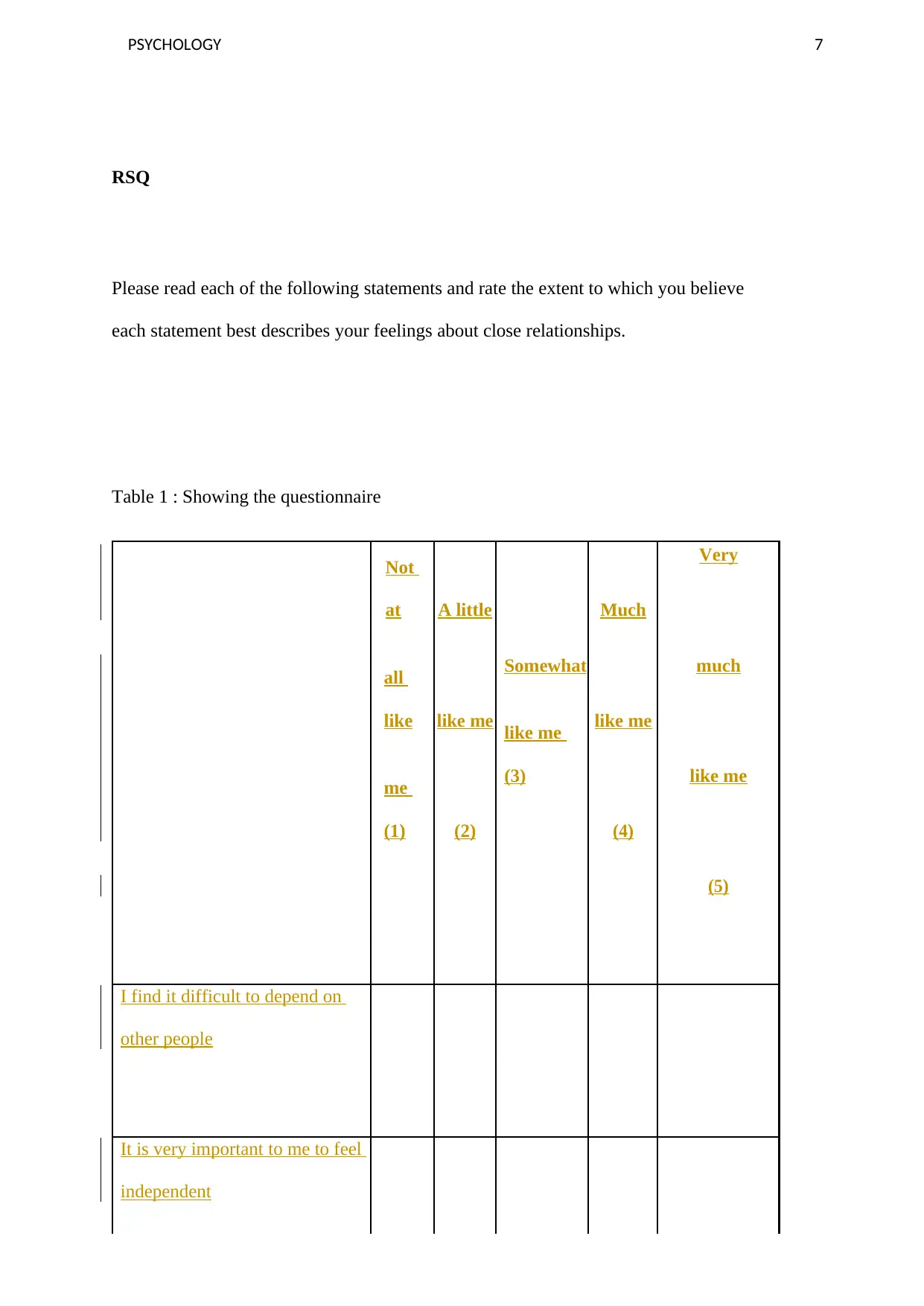
PSYCHOLOGY 7
RSQ
Please read each of the following statements and rate the extent to which you believe
each statement best describes your feelings about close relationships.
Table 1 : Showing the questionnaire
Not
at A little Much
Very
Somewhat much
all
like like me like me
like me
(3) like me
me
(1) (2) (4)
(5)
I find it difficult to depend on
other people
It is very important to me to feel
independent
RSQ
Please read each of the following statements and rate the extent to which you believe
each statement best describes your feelings about close relationships.
Table 1 : Showing the questionnaire
Not
at A little Much
Very
Somewhat much
all
like like me like me
like me
(3) like me
me
(1) (2) (4)
(5)
I find it difficult to depend on
other people
It is very important to me to feel
independent
Paraphrase This Document
Need a fresh take? Get an instant paraphrase of this document with our AI Paraphraser

PSYCHOLOGY 8
I find it easy to get emotionally
close to
others.
I want to merge completely with
another
person.
I worry that I will be hurt if I
allow myself to
become too close to others.
I am comfortable without close
emotional
relationships.
I am not sure that I can always
depend on
others to be there when I need
them.
I want to be completely
emotionally intimate
with others.
I worry about being alone.
I find it easy to get emotionally
close to
others.
I want to merge completely with
another
person.
I worry that I will be hurt if I
allow myself to
become too close to others.
I am comfortable without close
emotional
relationships.
I am not sure that I can always
depend on
others to be there when I need
them.
I want to be completely
emotionally intimate
with others.
I worry about being alone.
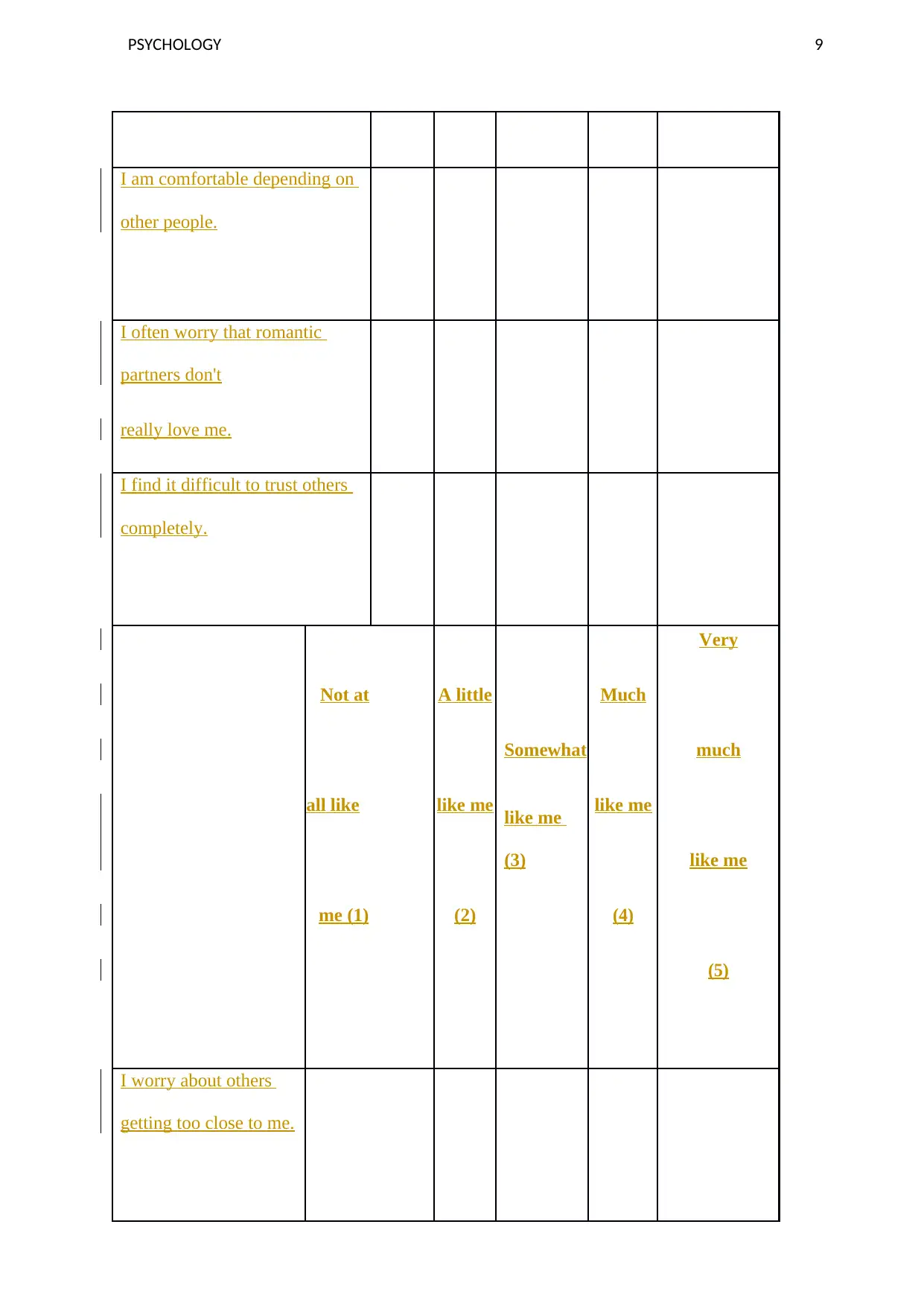
PSYCHOLOGY 9
I am comfortable depending on
other people.
I often worry that romantic
partners don't
really love me.
I find it difficult to trust others
completely.
Not at A little Much
Very
Somewhat much
all like like me like me
like me
(3) like me
me (1) (2) (4)
(5)
I worry about others
getting too close to me.
I am comfortable depending on
other people.
I often worry that romantic
partners don't
really love me.
I find it difficult to trust others
completely.
Not at A little Much
Very
Somewhat much
all like like me like me
like me
(3) like me
me (1) (2) (4)
(5)
I worry about others
getting too close to me.
⊘ This is a preview!⊘
Do you want full access?
Subscribe today to unlock all pages.

Trusted by 1+ million students worldwide
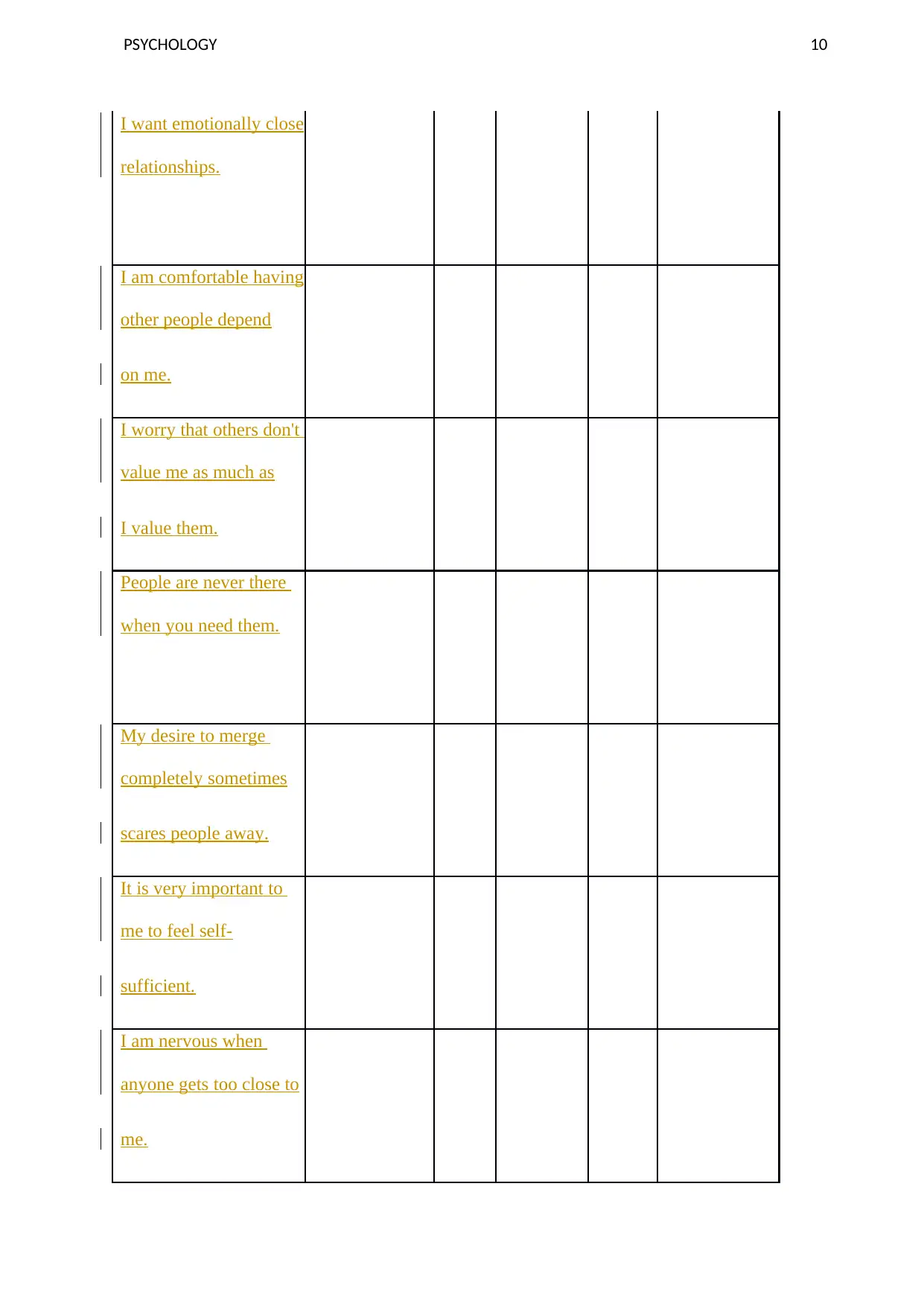
PSYCHOLOGY 10
I want emotionally close
relationships.
I am comfortable having
other people depend
on me.
I worry that others don't
value me as much as
I value them.
People are never there
when you need them.
My desire to merge
completely sometimes
scares people away.
It is very important to
me to feel self-
sufficient.
I am nervous when
anyone gets too close to
me.
I want emotionally close
relationships.
I am comfortable having
other people depend
on me.
I worry that others don't
value me as much as
I value them.
People are never there
when you need them.
My desire to merge
completely sometimes
scares people away.
It is very important to
me to feel self-
sufficient.
I am nervous when
anyone gets too close to
me.
Paraphrase This Document
Need a fresh take? Get an instant paraphrase of this document with our AI Paraphraser
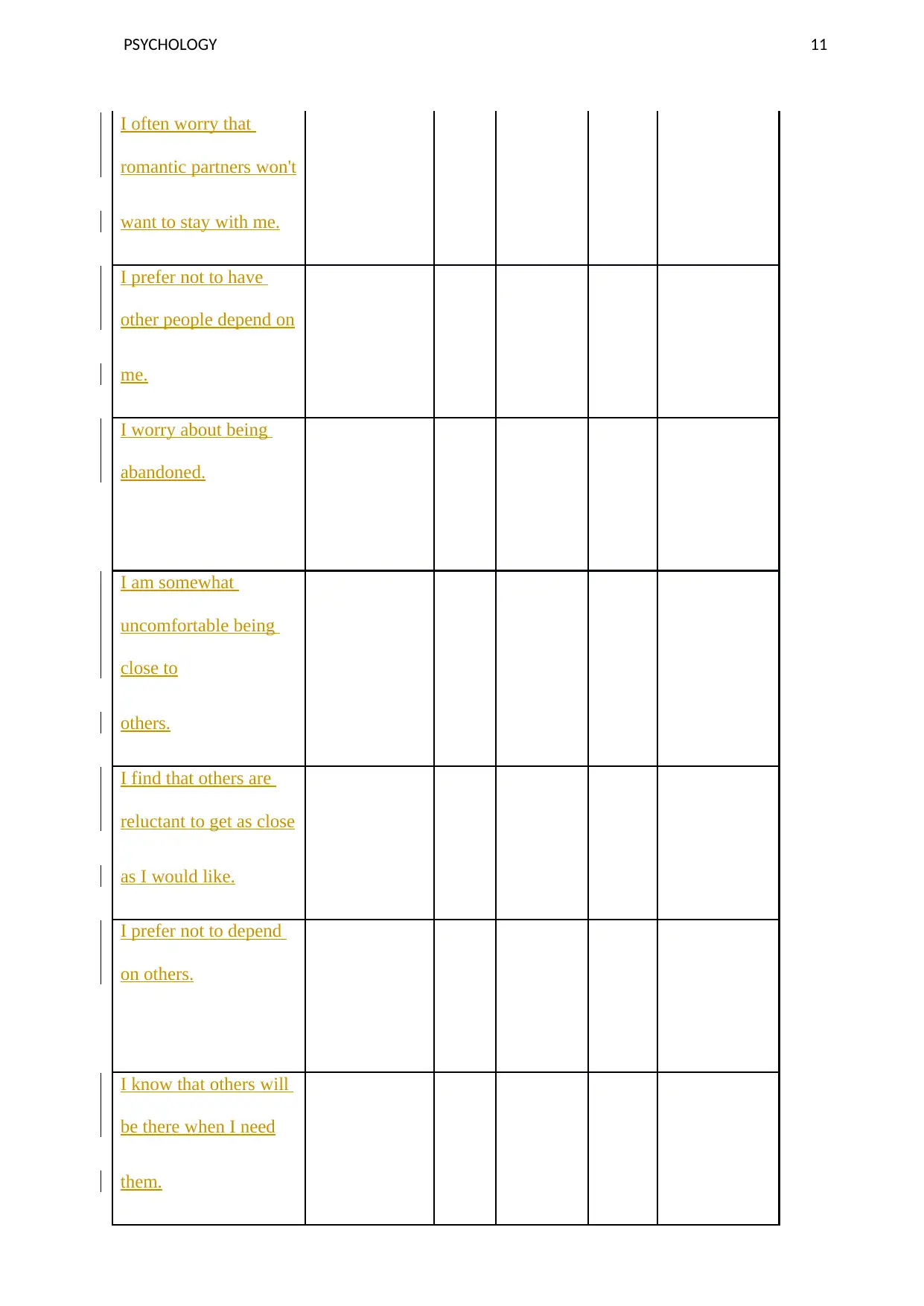
PSYCHOLOGY 11
I often worry that
romantic partners won't
want to stay with me.
I prefer not to have
other people depend on
me.
I worry about being
abandoned.
I am somewhat
uncomfortable being
close to
others.
I find that others are
reluctant to get as close
as I would like.
I prefer not to depend
on others.
I know that others will
be there when I need
them.
I often worry that
romantic partners won't
want to stay with me.
I prefer not to have
other people depend on
me.
I worry about being
abandoned.
I am somewhat
uncomfortable being
close to
others.
I find that others are
reluctant to get as close
as I would like.
I prefer not to depend
on others.
I know that others will
be there when I need
them.

PSYCHOLOGY 12
I worry about having
others not accept me.
Romantic partners often
want me to be closer
then I feel comfortable
being.
I find it relatively easy
to get close to others.
Not at A little Much
Very
Somewhat much
all like like me like me
like me
(3) like me
me (1) (2) (4)
(5)
I find it difficult to depend on other
people
I worry about having
others not accept me.
Romantic partners often
want me to be closer
then I feel comfortable
being.
I find it relatively easy
to get close to others.
Not at A little Much
Very
Somewhat much
all like like me like me
like me
(3) like me
me (1) (2) (4)
(5)
I find it difficult to depend on other
people
⊘ This is a preview!⊘
Do you want full access?
Subscribe today to unlock all pages.

Trusted by 1+ million students worldwide
1 out of 20
Related Documents
Your All-in-One AI-Powered Toolkit for Academic Success.
+13062052269
info@desklib.com
Available 24*7 on WhatsApp / Email
![[object Object]](/_next/static/media/star-bottom.7253800d.svg)
Unlock your academic potential
Copyright © 2020–2025 A2Z Services. All Rights Reserved. Developed and managed by ZUCOL.





